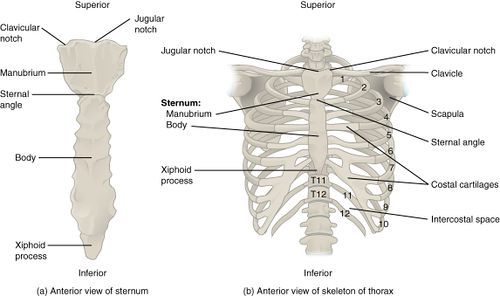Biomechanics of the Thorax
Original Editor - User Name
Top Contributors - Sonal Joshi and Manisha Shrestha
This article is currently under review and may not be up to date. Please come back soon to see the finished work! (15/12/2021)
Introduction[edit | edit source]
Biomechanics is an area of science that uses principles of physics to measure and study, how forces interact with and affect living body[1]. These forces could be Internal i.e. within the body or External i.e. outside the body.
To understand the biomechanics of thorax we will need to study the basic anatomy, joint articulations, muscles associated in the thorax along with kinematics of the rib cage.
The thorax is formed by the thoracic vertebrae ,the ribs and the sternum.
It has two main functions,
- Providing anchor for muscle attachments
- Major role of ventilation
Structure of Thorax[edit | edit source]
The main three structures mentioned above work in a coordinated motion in thorax to produce respiration.
Anatomy[edit | edit source]
- The rib cage is a system of various bones and muscle. Bones involved are sternum, 12 pairs of Ribs, 12 Thoracic vertebrae.
It is like a compartment sealed by various structures from each side.
- They can be described as[1],
| Side of compartment | Contents |
|---|---|
| Posterior-laterally | - Thoracic vertebrae
- Ribs - Intercoastal muscles and membrane |
| Anteriorly | - Coastal cartilages
- Sternum -Intercoastal muscles and membrane |
| Superiorly | - Upper ribs and clavicle
- Cervical fascia surrounding esophagus and trachea |
| Inferiorly | -Diaphragm muscle |
- The sternum consists of manubrium, body and xiphoid process. Its details can be referred to on page : sternum.
- The ribs are from T1 to T12 region
- Refer the Thoracic Anatomy for further details of Thoracic vertebrae & the joint which they form.
Articulations[edit | edit source]
| Joint | Bones involved in the joint articulation | Special features |
|---|---|---|
| Manubriosternal | Manubrium and superior part of body of Sternum | - Synchondrosis type of joint
- Also called Angle of Louis |
| Xiphisternal | Xiphoid process and inferior part of body of Sternum | - Synchondrosis type of joint
- Ossifies by 40 to 50 yrs. of age |
| Typical Costovertebral | - Synovial type of joint | |
| Costotransverse | ||
| Costochondral | ||
| Costosternal | ||
| Interchondral |
Function of Thorax[edit | edit source]
Kinematics[edit | edit source]
The motion of the ribs in conjunction with sternum and thoracic vertebrae helps produce the movements of respiration. These consist of inspiration and expiration. The changes in the ribcage
Muscles involved in Rib Cage[edit | edit source]
Primary Muscles[edit | edit source]
- Diaphragm
- Intercoastal muscles
- Scalene
Accessory Muscles[edit | edit source]
- Sternocleidomastoid
- Trapezius
- Pectoralis major
- Pectoralis minor
- Subclavius
- Levatores costarum
- Serratus posterior superior
- Serratus posterior inferior
- Abdominal muscles
- Transverse thoracis







